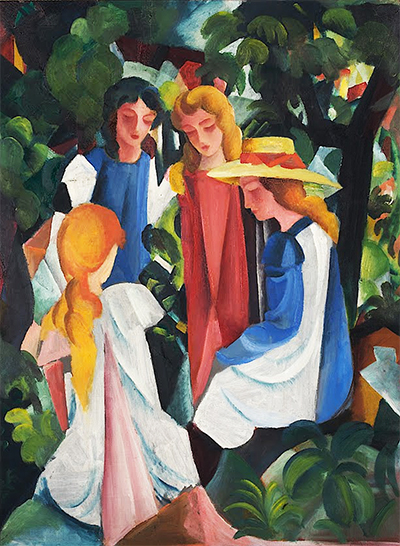This famous artwork from August Macke is loosely dated at between 1912-1913, though some sources also have it being finished one year later. It is now a part of the permanent collection of the Kunstpalast in Dusseldorf, Germany.
The charming content features four young girls huddled together in front of a background of trees and plants. They are dressed elegantly, suggesting a comfortable upbringing, with one sporting a stylish hat. Their dresses sweep elegantly to the bottom of the canvas and are made up predominantly of blue and white tones. This helps them to stand out from the greens of the foliage behind them. The light from the back is also carefully shaded across different sections of the scene, just as the artist carried out in a number of his other paintings at around this time, such as with At the Garden Table, which itself focused on a couple relaxing in their garden.
It is believed that this period of work from Macke was, in part, influenced by the work of the French Impressionists. He had spent some time in Paris studying their work several years earlier and was particularly taken by the colour schemes as well as the way in which their scenes were immediate and intriguing. One can debate over which elements of Four Girls were specifically related to this experience, but there can be no doubt of the impact of artists like Pissarro, Caillebotte, Bazille and Renoir on the overall style of this piece. The use of everyday activities was also partly impressed upon him from his time in France and in this example he concentrates on four girls spending time together, just as they probably would everyday after school had finished.
The artist was living in Bonn during the years of 1910 to 1913 and was starting to move towards a more abstract method of producing form. This painting came about before he had made the full progression, and so most of the forms here are still relatively easy to identify. The blocks of colour to produce them is another memorable element to his style, and later these would be changed again after his time spent in North Africa and experimenting more with watercolour techniques. Four Girls one of his most popular choices for art print reproductions because of the calming atmosphere found in this scene, with young girls and nature appearing to be at one with each other.




